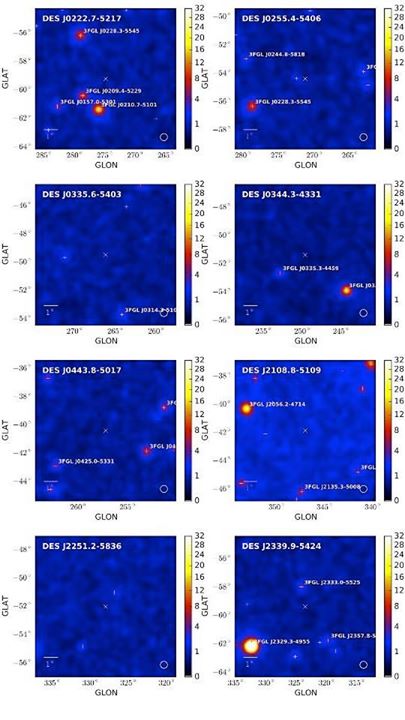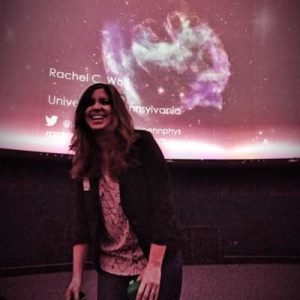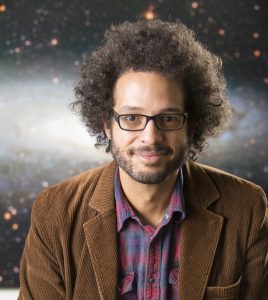Small satellite galaxies of the Milky Way are the most dark matter-dominated objects that we know of. Some theories suggest that dark matter is a new type of fundamental particle:a weakly interacting massive particle (WIMP). These particles could collide with one another and annihilate, leaving behind only high-energy gamma rays. In this case, Milky Way satellite galaxies would shine with the light of dark matter annihilation. In this paper, we use the Fermi Large Area Telescope (LAT; www-glast.stanford.edu) to look for a gamma-ray signal coming from dark matter annihilation in the Milky Way satellites recently discovered by the Dark Energy Survey.

The maps show gamma ray emission recorded by the FermiLAT at the locations of the DES satellite galaxy candidates and the surrounding region within 10 degrees. Each of maps in the figure are centered on a different satellite galaxy candidate. There is no strong excess of emission at the center of the images, the precise locations of the satellite galaxy candidates. Please see the attached paper for more details.
The Fermi spacecraft was launched in 2008 with the goal of understanding the extreme universe. Gamma rays are produced by some of the most energetic objects in the universe including supermassive black holes, exploding stars, and rapidly rotating neutron stars and magnetars. There is also the possibility that gamma rays could be produced from the annihilation of dark matter particles.
Dark matter makes up ~26% of the universe and outweighs normal matter by a factor of ~5. If dark matter is a new massive particle, it may annihilate to produce gamma rays. This means that regions of high dark matter density would be detectable by the FermiLAT.
Satellite galaxies are some of the closest and largest clumps of dark matter we can detect. While these galaxies are made up of hundreds of stars, they also are made up of much more dark matter than stars and gas. Since they don’t contain any of the energetic astrophysical mechanisms that usually produce gamma rays, the only signal expected would come from dark matter annihilation.
We use the FermiLAT to look at the eight new satellite galaxy candidates discovered by DES. We find no significant excess of gamma rays coming from any of the candidate galaxies. Even this lack of a signal tells us something important about the properties of dark matter: because we see no gamma rays we can set a limit on the rate at which dark matter annihilates. An independent group of researchers also searched for gamma-ray excess in a sample of newly discovered satellite galaxy candidates (http://arxiv.org/abs/1503.02632v1).
The FermiLAT collaboration has performed a search for gamma-ray excess on only confirmed (not candidate) satellite galaxies (http://arxiv.org/abs/1503.02641v1), finding no emission.
The analysis of satellite galaxies is complementary to searches for dark matter annihilation in the center of our galaxy. The center of the Milky Way is expected to have much more dark matter than the small satellite galaxies; however, it also contains many astrophysical mechanisms to produce gamma rays. There is thus a trade-off between the bright and complicated center of our Galaxy and the faint, simple satellite galaxies that surround it.
About the Paper Authors

Keith is a Kavli Institute for Cosmological Physics (KICP) fellow at the University of Chicago. His research interests are focused on the physics of satellite/dwarf galaxies, cosmic neutrinos and high-energy cosmic rays. Sometimes he goes to Antarctica for his work. Keith has been at KICP since 2012.

Alex is a Schramm fellow at Fermi National Accelerator Laboratory (FNAL) in Batavia, Illinois. His research interests are focused on satellite/dwarf galaxies, dark matter and gamma rays. In his spare time, he throws disk with the Chicago Wildfire (http://chicago-wildfire.com/). Alex has been at FNAL since 2013.
About The DArchive Authors & Editors

Rachel C. Wolf is an astrophysics PhD candidate at the University of Pennsylvania. She is primarily interested in how to best use Type Ia supernovae to understand more about the evolution of our universe. Most of her work has focused on studying correlations between supernova brightness and host-galaxy properties and on creating new statistical techniques to compare observational data to cosmology theory. Rachel is also very passionate about science education and public outreach. She is involved in many projects in the Philadelphia community and serves as one of the co-coordinators of Education & Public Outreach for DES.

Brian Nord is a post-doc at Fermi Accelerator National Laboratory. He did his graduate work on galaxy clusters and simulations of large-scale structure at the University of Michigan. He has been working with the DES strong lensing group for the past 3 years. Nord is also one of the co-coordinators of Education & Public Outreach for DES. Nord also does time lapse photography and has an encyclopedic memory of movies and television from the 1980’s.